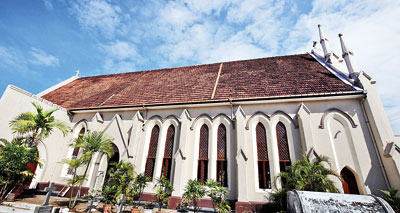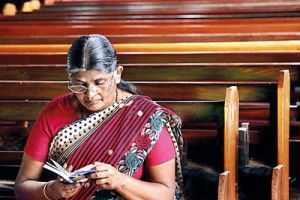Anytime is prayer time
Tiny and unpretentious it may seem when held up against other edifices, but it is unique in its own right.

Christ Church: The only “open door” church. Pix by M.A. Pushpa Kumara
Christ Church, off busy Galle Road, a stone’s throw from the hustle and bustle of Dehiwela junction, is the only “open door” church in Sri Lanka.
Not only during the day but throughout the night people are drawn to this Anglican church — for it is open 24-hours a day throughout the year.
As Christians the world over prepare to celebrate the birth of a Little Babe who spread hope and peace, this ‘sanctuary’ and place of succour too is aptly named after Him as Christ Church.
Instant is the response of Parish Priest Fr. Sam Ponniah when asked why he considers the church special. Even though his immediate flock consists of about 700 families from all three communities — Sinhalese, Tamils and Burghers, many are the men, women and children who walk into the nave and say a silent prayer before the altar.
“Some just stand in the doorway and murmur a quick prayer before hurrying away while others either kneel at a pew or sit around for awhile praying fervently,” he says, adding that non-Christians too step into the church for a moment of solitude.
 Pointing out that across the country, there may be shrines or parts of a church open throughout the day or giving a glimpse of an altar through some protective barrier, Fr. Ponniah says that Christ Church is open the whole of the day and night and has been since 1952.
Pointing out that across the country, there may be shrines or parts of a church open throughout the day or giving a glimpse of an altar through some protective barrier, Fr. Ponniah says that Christ Church is open the whole of the day and night and has been since 1952.
It was Fr. Felix Dias Abeysinghe, the then Vicar, seeing people “coming and going” at various times, due to the close proximity of the church to the junction, who suggested that it be kept open permanently. No matter what time of day it is, it could be a time for prayer.
Seated in his office, while the church gets a new coat of paint in preparation for the trilingual Carol Service today and the midnight service on December 24, Fr. Ponniah say that people on their way to the airport in the early hours stop by to seek blessings, while expectant mothers on their way to hospital do the same to ask for a safe delivery.
Fr. Ponniah has seen couples with no friends or relatives or even clergy, stand before the altar renewing their marriage vows on their anniversaries.
He remembers like yesterday, the incident of a little girl who had run away from her home in a village in Galle because she thought that her parents would stop her from continuing her education.

A time for reflection
“She had got off the bus at the halt close to the church one night and not knowing where she was or where she should go to, walked into the church. The security guard alerted me and I met the girl and spoke to her,” he says.
Realising her plight, Fr. Ponniah had requested the Salvation Army Home in Dehiwela to provide shelter to the child that night, to which there had been ready agreement. Coaxing her to give the contact details of her family, he himself had called them, got them to come the very same night, and checked them out to ensure that the girl was not facing any other issue.

Fr. Ponniah
“The reunion was poignant,” he recalls, reluctant to dwell on what may have happened if the church was closed and the girl had to spend the night on the streets of Dehiwela.
While the services at this church are unique with five being held each Sunday, where anyone can fit in, be it traditional, evangelical or conservative, the parishioners who have formed themselves into several groups engage in silent service to their brothers and sisters who are in need.
“Like the church being ‘open’, we are truly an ‘open’ community, open to giving and open to receiving,” he explains.
There has been pressure to instal close-circuit television cameras within the church to ensure that riff-raff will not walk in, says Fr. Ponniah, who has stood firm against it.
No one, except God should know who comes into the church to have a chat with Him, place their burdens at His feet and thank Him for blessings received, is this Parish Priest’s invincible argument.
A true rendezvous with God!
| Going back to the 1700s The history of Christ Church, Galkissa, rather than Dehiwela although very close to the junction of the latter, goes down the corridors of time to the early 1700s. Records maintained at the church indicate that according to the historian Valentyn the earliest reference to a church in Galkissahad been in 1705 – a pretty good church, roofed with tiles and built upon 10 masonry and 20 stone pillars, with a wall of clay 3½ ft high. However, by 1803, during British rule, the church had been roofless, although the pillars were in perfect condition and fit to support the roof. Being in close proximity to Governor Robert Brownrigg’s country residence in Mount Lavinia, he himself had evinced a personal interest in its restoration in 1820, meeting the cost from his pocket, after seeing a church wall slanting when attending a wedding. On February 16, 1843, the church had been consecrated by the Bishop of Madras, Rt. Rev. G.T. Spencer, marked by the purchase of a silver flagon and plate by subscription. Although the very precious flagon has been passed down the years and has pride of place at the church, the silver plate is believed to have been turned into the chalice and paten in use today. Going back in time, ‘gleanings’ recorded in the souvenir published on the 150th anniversary of the church which is now 171 years old, state that the wife of the first British Governor Frederick North built five churches on the island including Christ Church which was known then as the old church of Galkiest, on the island in fulfilment of a vow. However, a letter sent by Colonial Chaplain Twistleton to the Chief Secretary of the Government indicates only restoration of the church by Lady North. Mystery also surrounds the ‘place-name’ of the church. While scholars have not agreed on its etymology, there are two schools of thought. The first links the church with the name of the village of Galkissa, a corruption of the name ‘Gal Vissa’ (20 stone pillars) from the structure of the church as it appeared in Dutch times. The second argues for ‘gala’ meaning ‘rock’ or ‘stone’ with ‘kissa’ variously explained as ‘key’ (‘kissa’ or ‘kessa’) either from the similarity of the hill to a key or some other reason or ‘cove’ or ‘bay’ (kissa). The existence of a rocky bay in the area makes this explanation the more suggestive. The rock or hillock is too conspicuous not to associate itself with a place-name, records state. Whatever is in a name, the importance of the site is obvious – for in the small graveyard on one flank of the church lies two tombs under the protection of the Department of Archaeology. |


